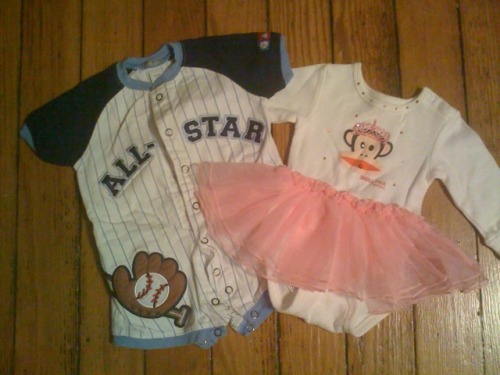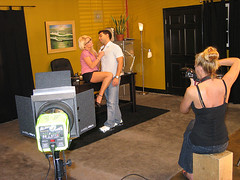Though two new shows in the fall line-up – Once Upon a Time and Grimm – both use fairy tales as the basis for their narratives, blending the ‘real world’ with the ‘fairy tale’ world, the similarities pretty much stop there. The two shows are radically different – and especially so in their representation of gender. Grimm has far less of a female focus and frames women as victims, functioning like CSI: The Fairy Tale Version while Once Upon a Time is centered around strong female characters, functioning as a sort of Snow White: Disney Princess Slayer.
Much like Hoodwinked, Grimm functions as a fairy-tale crime scene retake. However, while Hoodwinked gave us a wise-talking Red and a go-to Granny, Grimm focuses on a male detective and thus far has put females on the sidelines – and, in accordance with rape culture – represents them as potential victims who had better “stay out of the forest” it they want to stay safe.
The season premiere opened with a young woman jogging in a red-sweatshirt listening to the Eurhythmics song Sweet Dreams, a song that will later be hummed by her wolfy attacker as he ominously adds another red sweatshirt to his basement wardrobe collection, indicating he has kidnapped and killed quite a few ‘litte Reds.’ As the use of the Eurhythmics song suggests “some of them want to abuse you.” Never fear though, as the intrepid male detective duo of Nick Burckhardt (David Guintoli) and Hank Griffin (Russell Hornsby) are on the wolf’s track, serving as would-be woodsmen to save red damsels in distress.
Earlier, these same two detectives watch women walking down a street. Hank asks David “What you looking at?,” to which David notes that something seems remiss about one of the women, noting her low salary does not match her Armani outfit. Hank scoffs in reply “Why can’t you just watch her ass like the rest of us?” This may be the most obvious moment of a sexualized male gaze in the premiere, but other aspects of the show indicate it will be more akin to Supernatural (where two male leads are the key demon hunters) than to Alias (where a strong woman was front and center).
Granted the premiere introduces us to Mary – Nick’s guardian since he was 12. She is the one strong woman thus far, telling Nick about his true “fairy tale hunter” identity and then battling a monstrous baddie. This fight lands her in hospital (and if male-hero Nick hadn’t shot the monster, would have likely resulted in her death). This, and the fact she earlier told Nick she’s been given only weeks to live, suggests Mary won’t be around for long – too bad, as putting (good) strong women at the helm of fairy tales is a rare occurrence – there are plenty of evil female villains, but not many heroines, unless you consider talking to animals or finding a prince a particularly heroic trait.
The most intriguing plot point of the premiere comes when Nick targets the wrong creature, a reformed wolf. The wolf/human insists on his innocence, angrily telling Nick “you people started profiling us over 200 years ago.” It will be interesting to see if the show builds on ideas of racial profiling or if (please!) it includes some strong women and non-prince charming detectives, until it does, I will get my strong-women-in-fairy-tales fix watching Once Upon a Time.
Once features not only a re-vamped Snow White, but her kick-butt daughter, Emma Swan.
While in Grimm, the setting is modern-day Oregon, in Once, the characters are trapped between two worlds – the fairy-tale past and the modern world, including the town of Storybrooke, where an evil spell cast by the Queen has frozen all the fairy-tale characters in time and taken away their awareness of who they are. In the modern world, The Queen is Storybrooke’s dictatorial mayor, and her adoptive son Henry is on a quest to save the day. He seeks out Emma Swan, the daughter of Snow White, who lives in Boston and works as a bail bondsperson that reveals the “evil” of philandering men. Not knowing her “true identity,” Emma goes with Henry to Storybroooke, staying there when he convinces her only she can undo the curse.
Thus far, it is not clear who knows they are stuck in a fairy tale and who doesn’t, but the lavish costumes, special effects, and attention to fairy-tale detail makes for a show that is far more enchanting than the film Enchantment – Disney’s attempt at a fairy tale redux that, in spite of excellent turns by Amy Adams as princess and Susan Sarandon as Evil Queen, ultimately gave us the same old message – someday your prince will come, he will “save” you, and your “happy ending” equals being a happy wife/mother.
Where Enchantment failed in a typical Disney way – by trying to “modernize” a sexy message and make it palatable via the inclusion of catchy tunes and cute talking animals, Once succeeds by NOT being cute – instead we have the nasty Rumpelstilskin morphed into the modern evil capitalist Mr. Gold, the newfangled Snow as an excellent, caring elementary school teacher, little Red and the Fairy Godmother as hotel proprietors, and Jiminy Cricket as child therapist. Further, though the show accords with the “evil stepmother” meme of fairy tales – it complicates it as well, suggesting that “evil” women might just be the result of a society that does not value single mothers and questions powerful women in the workforce.
But, the biggest difference is the fact Emma Swan is framed as the heroine – that her “happy ending” is NOT about finding a man or going to a ball all gussied up, but about detective work, about building a relationship with her son Henry, and about seeking the “truth” as to why time stands still in the corrupt Storybrooke world. For once a female is poised to be the hero – and with no prince charming by her side. Woot!
The themes and content of the show thus far circulate around issues of gender, class, education, mothering/parenting, beauty, aging, and power – yes, these are common fairy tale concerns, but the difference is Once – at least so far – takes fairy tale tropes and give them a feminist/social justice twist.
The queen/mayor is not just an evil witch of the all powerful women are bad, but a woman stuck within capitalist patriarchy – where Mr. Gold (Rumplestilskin) calls the shots. Even more intriguingly, Maleficent (played by True Blood’s Kristin Bauer van Straten) is portrayed as recognizing the bind inherent in the good/evil binary and the way it too simplistically frames some women as witches, and others as princesses. In one humorous scene, The Queen and Maleficent complain about Snow White and Sleeping Beauty, noting how those prissies ruined their lives. Underneath this banter lies the suggestion that what really turned them evil was neither Snow or Sleeping, but patriarchy and the marriage imperative imposed by fathers.
The show also interestingly puts a new twist on “true love” – the focus of so many fairy tales. When the Queen wants to release her dark curse, Rumplestilskin tells her she must sacrifice “the heart of the thing you love most,” which we soon discover is not some Prince Charming character, but her father. Just before she kills him, her father tells her “Power is seductive, but so is love, you can have that again…I believe given a chance we can find happiness again, but the choice is yours.” Alas, she chooses power over love and kills him, using his heart for the curse that transports the fairy tale inhabitants to Storybrooke and freezes them forever in time.
Henry, who bears the namesake of the slain father of the Queen, seeks Emma out to release the curse, telling her she is the only one who has the power to do so. Embedded within this quest is Henry’s own search for true motherly love. However, the show is careful not to suggest that Emma’s love is “better” or “natural” because she is his biological mother – rather, it suggests that, as a good person, she cannot help but help Henry, and in doing so, she disproves her claim that she is “not fit to be a mother.” The show also is careful not to demonize her for putting Henry up for adoption and notes the age/class factors that contributed to her decision. Moreover, it opens out what “mothering” means – it is not about having money and power (like the Queen/Mayor), but about the type of nurturing both Emma and the newfangled Snow White (Henry’s elementary school teacher) offer Henry.
Emma of course doesn’t believe she can save Henry nor Storybrooke, but, as Henry points out, “the hero never believes at first, if they did, it wouldn’t be a very good story.”
As for me, I believe this is going to be one heck of a good story, and I hope against hope that it will lead to the “happy ending” of finally FINALLY! having a mainstream fairy-tale that doesn’t sideline females or suggest they are only good for cleaning up after dwarves, marrying princes, or beautifully sleeping. As for me, I am not awaiting “true love’s kiss” – nope, I am counting the days until episode two of Once Upon a Time.



 Ask me five years ago and I’d have told you I’d be first in line to challenge gender stereotypes if ever I had kids myself. I minored in feminist cultural studies! I believe boys and girls are made, not just born! But sixteen months into parenting my boy/girl twins, I’m starting to wonder how I’ll ever ensure that my boy grows up sensitive and my girl stays, as
Ask me five years ago and I’d have told you I’d be first in line to challenge gender stereotypes if ever I had kids myself. I minored in feminist cultural studies! I believe boys and girls are made, not just born! But sixteen months into parenting my boy/girl twins, I’m starting to wonder how I’ll ever ensure that my boy grows up sensitive and my girl stays, as 
